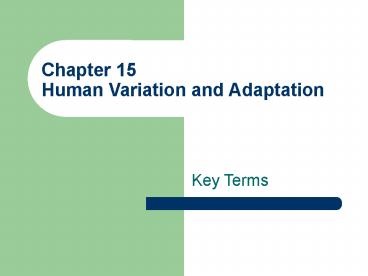Chapter 15 Human Variation and Adaptation - PowerPoint PPT Presentation
Title:
Chapter 15 Human Variation and Adaptation
Description:
Chapter 15 Human Variation and Adaptation Key Terms monogenism Theory that all humans were descended from a original pair of humans. polygenism Theory that all humans ... – PowerPoint PPT presentation
Number of Views:99
Avg rating:3.0/5.0
Title: Chapter 15 Human Variation and Adaptation
1
Chapter 15Human Variation and Adaptation
- Key Terms
2
- monogenismTheory that all humans were descended
from a original pair of humans. - polygenismTheory that all humans were descended
from a number of pairs of humans.
3
- plasticityThe ability of organisms to make
alterations in order to respond to differing
conditions. - dolichacephalicHaving a long, narrow head in
which the width measures less than 75 of the
length.
4
- brachycephalicHaving a broad head in which the
width measures more than 80 of the length. - biological determinismConcept that various
aspects of behavior are governed by biological
factors inaccurate association of various
behavioral attributes with certain biological
traits such as skin color.
5
- eugenicsPhilosophy of race improvement through
the forced sterilization of members of some
groups and encouraged reproduction among others. - polytypicReferring to species composed of
populations that differ with regard to the
expression of one or more traits.
6
- stressIn a physiological context, any factor
that acts to disrupt homeostasis more
precisely, the bodys repose to any factor that
threatens its ability to maintain homeostasis. - homeostasisA condition of balance, or stability,
within a biological system, maintained by the
interaction of physiological mechanisms that
compensate for changes.
7
- acclimatizationPhysiological response to changes
in the environment that occurs during an
individuals lifetime. - neural tubeIn early embryonic development, the
anatomical structure that develops to form the
brain and spinal cord.
8
- spina bifidaA condition in which the arch of one
or several vertebrae fails to fuse and form a a
protective barrier around the spinal cord. - vasodilationRefers to widening (dilation) of the
capillaries near the skin's surface permitting
"hot" blood from the body's core to dissipate
heat to the surrounding air.
9
- vasoconstrictionNarrowing of blood vessels to
reduce blood flow from the skin. - vectorsAgents that serve to transmit diseases
from one carrier to another.
10
- endemicContinuously present in a population.
- pathogensSubstances or microorganisms, such as
bacteria, fungi, or viruses, that cause disease.































